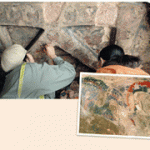 Buddhist artists in Bamiyan, Afghanistan, may have painted with oils centuries before European Renaissance painters developed the technique.
Buddhist artists in Bamiyan, Afghanistan, may have painted with oils centuries before European Renaissance painters developed the technique.
A team led by Marine Cotte at the European Synchrotron Radiation Facility in Grenoble, France, has analyzed tiny samples of paintings sent by a UNESCO conservation team from a site where the Taliban destroyed two giant Buddha statues in 2001. Initial scans with ultraviolet light led researchers to suspect the presence of oil, and “we have confirmed it,” says Cotte. Twelve of 50 murals depicting colorful Buddhas and mythical creatures, painted in caves behind the statue niches, included pigments bound in plant oils. Oil offers “more freedom” to artists, says Cotte, as it doesn’t set instantly like the gypsum or calcium salt pigments also used in the caves.
Helen Howard of the National Gallery in London says European oil paintings date back to the 12th century, but whether oil was used earlier isn’t known because “analysis hasn’t often been carried out on very early paintings.” UNESCO team leader Yoko Taniguchi of the National Research Institute for Cultural Properties in Tokyo said in a statement that ancient Romans and Egyptians were known to use drying oils, but only as medicines and cosmetics. Thus, the team writes in April’s Journal of Analytical Atomic Spectrometry, the Afghan samples could be the “oldest example of oil paintings on Earth.”
Originally appeared in Science Magazine as a Random Sample: [html] [pdf]
 Smokers tend to resist antismoking efforts that rely on “rational” approaches such as taxes, and researchers have pointed to confounding influences, including social factors and addiction. But differences in smokers’ decision-making processes may also be at play.
Smokers tend to resist antismoking efforts that rely on “rational” approaches such as taxes, and researchers have pointed to confounding influences, including social factors and addiction. But differences in smokers’ decision-making processes may also be at play.
